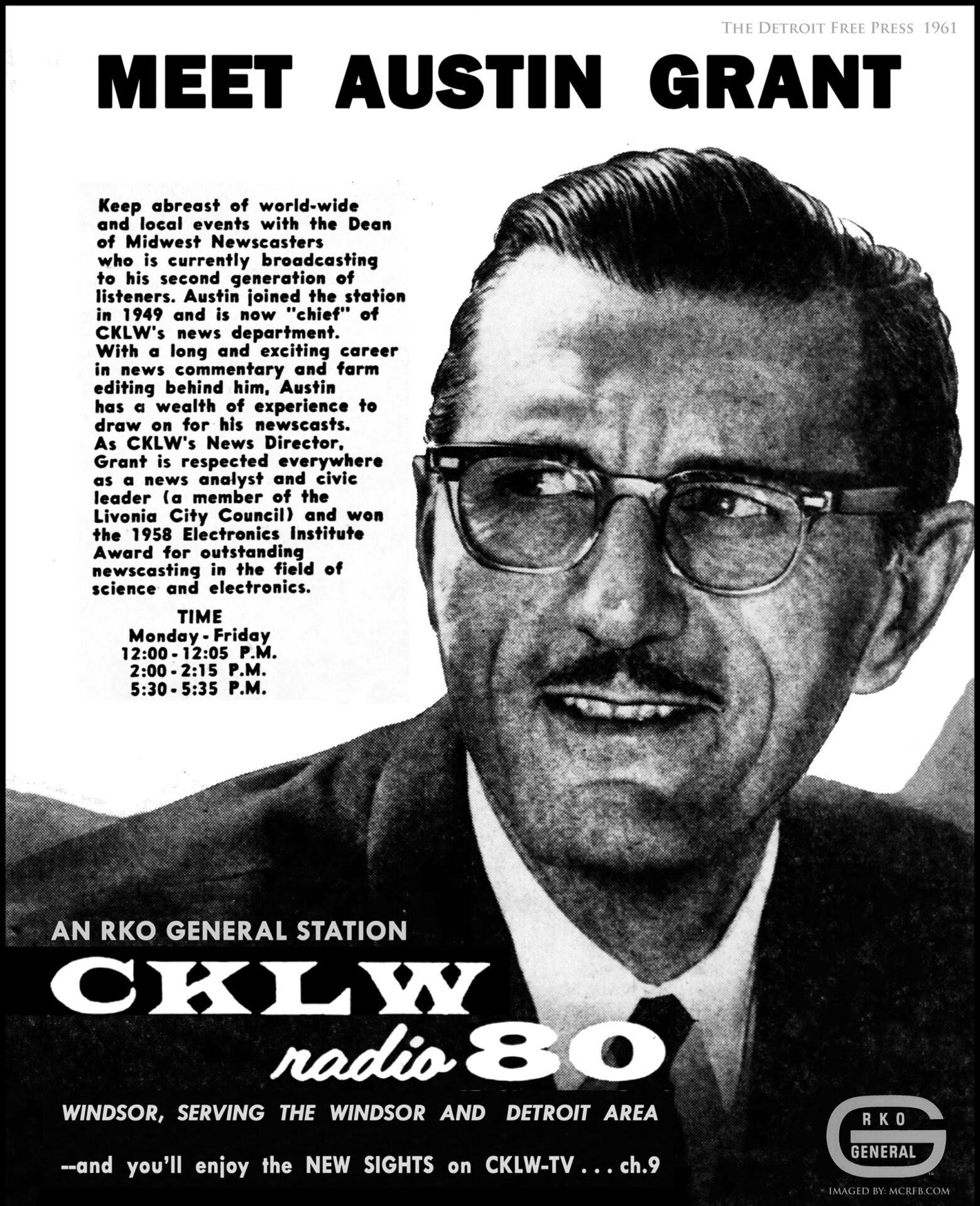![]()
Category: Flashbacks
RKO CKLW 80: APRIL 9, 1961 [Detroit Free Press] RADIO BACK-PAGE AD
Above article/advertisement courtesy freep.com newspaper archive. Copyright 2023. Newspapers.com
The above featured Detroit Free Press CKLW advertisement/ article was digitally re-imaged by Motor City Radio Flashbacks
Missed any of our previous ‘Detroit Radio Back-Pages‘ features? GO HERE

![]()
 MCRFB Note: Special THANKS to our friend, John Bartony (a.k.a. Jukebox John) St. Clair Shores, Michigan, for providing the above Detroit Free Press CKLW RKO General ad (April 1961) for this site, as featured today.
MCRFB Note: Special THANKS to our friend, John Bartony (a.k.a. Jukebox John) St. Clair Shores, Michigan, for providing the above Detroit Free Press CKLW RKO General ad (April 1961) for this site, as featured today.
A special thank you to senior MCRFB consultant Greg Innis, of Livonia, MI., for contributing the Newspapers.com archives (Detroit radio related) articles, ads, and images we have provide for this site since 2016.
Thank you, Greg Innis, for making these historic Detroit radio features possible. 🙂

![]()
 ON YOUR PC? You can read this entire newsprint article/ad — the fine print — ENLARGED. For a larger detailed view click above image 2x and open to second window. Click image anytime to return to NORMAL image size.
ON YOUR PC? You can read this entire newsprint article/ad — the fine print — ENLARGED. For a larger detailed view click above image 2x and open to second window. Click image anytime to return to NORMAL image size.
Click your server’s back button to return to MCRFB.COM home page.
ON YOUR MOBILE DEVICE? Tap on newsprint image. Open to second window. “Stretch” image across your device screen to magnify for largest print view.

![]()
THIS WEEK IN BILLBOARD: THE NATION’S TOP LPs! WEEK ENDING, OCTOBER 16, 1965
Eight weeks on the Billboard LP’s chart, The Beatles’ ‘Help‘ is at the #1 spot, week-ending, October 16, 1965. The American LP version of Help! reached the number one spot on the Billboard Top LPs chart for nine weeks starting on 11 September 1965. In the US, the Capitol album sold 1,314,457 copies by 31 December 1965 and 1,594,032 copies by the end of the decade [Source: Help (Album) Wikipedia]
_______________
The above Billboard LPs 10/16/65 chart was digitally re-imaged and restored in its entirety by Motor City Radio Flashbacks

![]()
![]() ON YOUR MOBILE DEVICE? Tap over Billboard LP’s chart image. Open to second window. “Stretch” image across your device screen to magnify for largest print view.
ON YOUR MOBILE DEVICE? Tap over Billboard LP’s chart image. Open to second window. “Stretch” image across your device screen to magnify for largest print view.
ON YOUR PC? Click on all chart images 2x for largest print view.
![]()
WJLB IN NEW PROGRAM POLICY . . . SEPTEMBER 23, 1967
 New Detroit R&B Soul Station PD Will Launch “Young Sound” and Apply Consistency To Programming
New Detroit R&B Soul Station PD Will Launch “Young Sound” and Apply Consistency To Programming
DETROIT — WJLB, Booth Broadcasting’s 1,000-watt R&B operation here, has just launched a new programming policy centering around tighter production, faster pacing, and a new set of custom jingles created and packaged by Quincy Jones.

Wash Allen, who just recently took over WJLB program director duties after being transferred from Booth’s WABQ in Cleveland, said the Detroit station would be “running with a full-blast, exciting young sound.” Playlist will be 40 records, to which he will add as necessity demands. “You can never tell how many good tunes will come out in a good week, but I think the average will be about five new records a week,” he said.
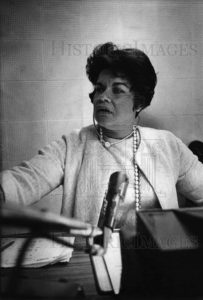
The aim will be to establish consistency in programming, Allen said. He felt his philosophy in programming was the same as Bill Drake, consultant to RKO General stations, and Paul Drew, program director of CKLW in Detroit. “Certain top tunes must be played consistently and deejays must be consistent in their shows. One dee-jay can’t make a station; it has to be a total operation and this is a new concept in R&B radio. In the old days, one guy could make a station; he could make a record. It can’t be like that today.”
Things are changing so fast in radio, especially in R&B radio, that Allen felt many older dee-jays were finding it difficult to grasp what was happening. “To some extent,” Allen said, “it was necessary to teach radio to these people. It wasn’t anybody’s fault that this situation developed. It’s just that times are changing and a radio station has to move with the times.”

Allen began his radio career with WVOL in Nashville while attending Tennessee State University. He had been with WABQ about two and a half years before moving to WJLB. He considers himself a “derivative of Ed Wright,” who’d been program director of WABQ prior to joining Liberty Records as head of its Minit label.
Allen wrote lyrics and produced the Jones jingles. Future plans call for psychedelic jingles. Station has brought in new equipment and is building up its news department. In Martha Jean Steinberg and Ernie Durham, Allen felt he had two of the top air personalities of any station in the nation. “Now, with the new equipment, we find we have everything to work with. END
_______________
Information, credit, and news source (as was published): Billboard; September 23, 1967
![]()
BLITZ MAGAZINE | CKLW RADIO LEGENDS, BURTON CUMMINGS, HONOR CKLW MUSIC DIRECTOR ROSALIE TROMBLEY
 The Rosalie Trombley Commemorative Day Event: Windsor, Ontario. Sunday, September 17, 2023
The Rosalie Trombley Commemorative Day Event: Windsor, Ontario. Sunday, September 17, 2023
FROM BLITZ MAGAZINE’S WEBSITE and FACEBOOK PAGE
By Michael McDowell
If you believe that the 1970s represented a banner era for hit singles, you can thank Rosalie Trombley.
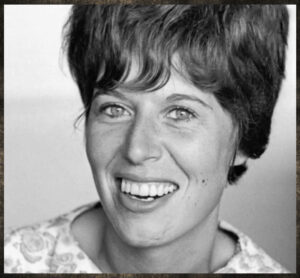
The position of Music Director at a radio station could vary widely in terms of aesthetic gratification, commensurate with the state of the art. For such visionaries as Frank “Swingin’ ” Sweeney and Paul Cannon (who each held the position at suburban Detroit’s legendary WKNR Keener 13 throughout the mid to late 1960s), being Music Director meant selecting an average of six to ten new singles for airplay out of the roughly 300 to 600 stellar new releases that surfaced each week throughout that most dynamic and creative of musical eras.
However, doing so meant that hundreds of landmark singles were overlooked at the time of their release. For the past several decades, Blitz Magazine – The Rock And Roll Magazine For Thinking People has been working in tandem with countless musicologists and record collectors around the world to chronicle, celebrate and archive that tremendous body of material.
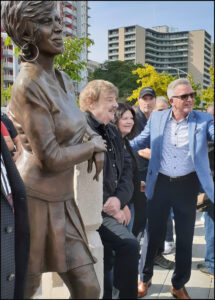
Conversely, with mainstream music at large having entered into a protracted aesthetic slump by the end of the 1960s, the job of Music Director by definition required a great deal more due diligence in order to sustain the momentum that had been generated by the likes of Sweeney and Cannon. As Music Director for Windsor, Ontario’s CKLW-AM throughout that period, Leamington, Ontario native Trombley nonetheless managed to separate the wheat from the chaff in similar fashion. In the process, she helped enable The Big 8 to dominate the North American market throughout the decade.
On the morning of Sunday the seventeenth of September, hundreds of radio and entertainment industry veterans gathered together with Trombley’s family and friends at Windsor’s Open Streets Festival along Riverside Drive for the unveiling of a statue in her honor. Windsor Mayor Drew Dilkens was joined in his opening remarks by Saint Clair College President Patti France, statue artist Donna Jean Mayne and others, including former Deverons and Guess Who vocalist and keyboard man, Burton Cummings.
“I remember the few times I really talked to Rosalie”, said Cummings.
“She really knew the stuff. There are many musicians who are very talented, who didn’t make it. I never took that for granted. Because of Rosalie, I still hear myself on the radio all the time. And she was there, right at the launching point”.
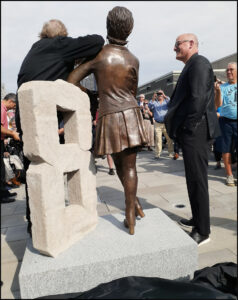
Following the unveiling of the statue by Cummings, CKLW veteran and big8radio.com CEO Charlie O’Brien and others, Saint Clair College hosted a lunch reception for the industry vets in attendance. Also on board were CKLW legends Len Robinson, Pat Holiday, Ted Richards, JoJo Shutty-MacGregor and Joe Donovan, along with Motor City Radio Flashbacks’ curator Jim Feliciano, Edison Media Research’s Sean Ross, renowned musicologist Jim Johnson and Trombley’s son, Tim.
At the reception, Tim Trombley shared at length about his mother’s unwavering ability to balance her pioneering work at CKLW with her ongoing responsibilities as a single parent, In the process, he provided one of the event’s most moving moments.
Conversely, Richards spoke of Trombley’s lighter side by sharing the secret of “the record that Rosale hated”.
“It was C.W. McCall’s Convoy”, Richards said, in reference to the November 1975 MGM label tale of the world of truck drivers and their CB radios.
“We aired it late at night!”
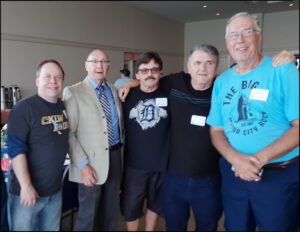
Nonetheless, all concurred that Trombley (who succumbed to a lengthy battle against Alzheimer’s disease in her native Leamington in November 2021 at age 82) was unwavering in her determination to keep the atmosphere in the CKLW studios like that of one big, happy family.
“We had fun!”, said Holiday.
To be certain, it was fun that was augmented by gratitude. And perhaps no individual at the day’s festivities was more grateful in that respect than Cummings.
Having left the Deverons in 1966 to join the Guess Who for the release of their third album, ‘It’s Time’, the band went on to sign with Larry Uttal’s Amy label in the United States. At Amy, the Guess Who released their Dave Clark Five – inspired “His Girl” single.
Meanwhile, the Guess Who continued to record for Quality at home. The results included such magnificent singles as Clock On The Wall and their ambitious cover of Buffalo Springfield’s “Flying On The Ground Is Wrong”.
However, with the departure of original front man Chad Allan (who had provided the lead vocal for the Guess Who’s 1965 monster classic cover of Johnny Kidd And The Pirates’ “Shakin’ All Over” for Florence Greenberg’s Scepter label), the band remained in transitory mode for more than a year. In addition to those various projects for Amy and Quality, they managed to sustain their momentum in part by hosting a musical variety television series from their native Winnipeg, Manitoba.
But thanks to Rosalie Trombley, that all began to change at the end of 1968.

Around the time they had completed a joint album project at home with Capitol Records stalwarts, The Staccatos, The Guess Who switched label affiliations to RCA Victor in the United States and Nimbus in Canada. Their resultant Wheatfield Soul album produced an ambitious original ballad (composed by Cummings and Guess Who lead guitarist Randy Bachman), “These Eyes”.
After that single had enjoyed brief success at home in late 1968, Trombley lent her support to the record, putting it in heavy rotation at CKLW in the early weeks of 1969. The single became an instant classic.
One magnificent Guess Who single after another followed in succession, from mid-1969 throughout the first half of the 1970s. Among the highlights were “Laughing / Undun”, “No Time”, “American Woman” / “No Sugar Tonight”, “Hand Me Down World”, “Rain Dance”, “Albert Flasher”, “Dancin’ Fool”, “Share The Land” / “Bus Rider”, “Sour Suite”, “Glamour Boy”, “Orly” and their sublime signature single,” Running Back To Saskatoon”. Without exception, Trombley afforded each and every one of them heavy rotation at CKLW.
“When it comes to Rosalie Trombley, I have no problem saying very easily that she changed my life”, said Cummings. “It would occur to me once in a while that if it weren’t for Rosalie, I wouldn’t be here.
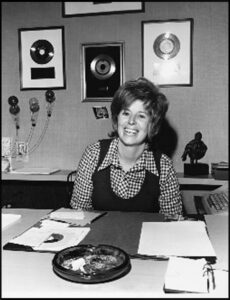 “I kept a journal, as we didn’t have laptops back then. We traveled all over the world. I wouldn’t have had that luxury had Rosalie Trombley not launched our first (RCA Victor) record.
“I kept a journal, as we didn’t have laptops back then. We traveled all over the world. I wouldn’t have had that luxury had Rosalie Trombley not launched our first (RCA Victor) record.
“Rosalie was a huge part in launching that record. This was the gateway into Detroit, where a lot of people heard it for the first time. I would not have a wall of beautiful gold records at home, were it not for Rosalie. For that, I am eternally grateful. I will never forget her.”
The statue of Rosalie Trombley can be viewed from Riverside Drive at the intersection of McDougall Street.
—Mike McDowell September 19, 2023
Copyright 2023. Blitz Magazine. All rights reserved.
![]() A special THANK YOU to Mike McDowell, Editor of Blitz Magazine, for his guest article published here today at Motor City Radio Flashbacks.
A special THANK YOU to Mike McDowell, Editor of Blitz Magazine, for his guest article published here today at Motor City Radio Flashbacks.
All photographs were taken and is property of Mike McDowell.
A special THANK YOU to Terry Scott. The You Tube video presentation below is courtesy of CKLW 580 newsman Terry Scott.
Also, visit the newly-launched website (September 17, 2023), ‘Honouring Rosalie Trombley’, go HERE
_______________
![]() A MCRFB Note: For detailed and enlarged viewing of all images presented here, double-click over each photo with your PC mouse. Tap over photo and stretch image across your mobile device window for expanded detailed view.
A MCRFB Note: For detailed and enlarged viewing of all images presented here, double-click over each photo with your PC mouse. Tap over photo and stretch image across your mobile device window for expanded detailed view.
![]()
GAVIN REPORT | PROGRAM DIRECTOR SHOULD MEAN PEOPLE DIRECTOR . . . SEPTEMBER 19, 1964
By BILL GAVIN
Billboard Contributing Editor
PROGRAM DIRECTORS handle a multitude of problems. They deal with promos, jingle packages, formats, news, music and everything else that goes on the air. At many smaller stations their jobs also include supervision of commercial production for local advertisers. The manifold responsibilities of a program director test his skills and try his patience. Of all his jobs, none is so important and none so difficult-as obtaining optimum effectiveness from his staff of disk jockeys.
It has been said that the most successful PD is the one who does the least directing. It could be said more accurately that the most fortunate PD’s are those who need to do the least directing. In an ideal situation, the PD can say “Here’s our policy–here’s our music–you’re all pros–you know how to do good shows–so go!”
 There are hardly more than a dozen stations in the U. S. where the staff quality permits the PD to get away with such a do-it-yourself policy. The great majority of disk jockeys, with all their many skills and talents, do better jobs with some coaching, directing, urging, scolding, prodding and whatever other devices the PD may devise. The initials “PD.” which are synonymous with “Program Director,” could just as well stand for “People Director.”
There are hardly more than a dozen stations in the U. S. where the staff quality permits the PD to get away with such a do-it-yourself policy. The great majority of disk jockeys, with all their many skills and talents, do better jobs with some coaching, directing, urging, scolding, prodding and whatever other devices the PD may devise. The initials “PD.” which are synonymous with “Program Director,” could just as well stand for “People Director.”
Consider some of the combinations of talent and temperament which the PD must weld into an effective air force:
1. The witty DJ, who is clever and amusing, but who knows little and cares less about his music.
2. The DJ who depends on a set bag of tricks, but who seldom comes up with a fresh, original idea.
3. The record “expert,” whose poor voice and bumbling reading of copy are somewhat compensated for by his contagious enthusiasm about his
music.
4. The erratic genius, who poses a constant threat of embroiling the station in libel suits and license difficulties.
5. The conformist who plays it safe by running his shows according to the book, never doing anything wrong but never rising much above the minimum requirements.
6. The restless wanderer, always with an eye on the bigger job, whose long-distance approaches to other stations eventually reach the ears of his own boss.
7. The young prospect who shows signs of talent, and whose apparent potential persuades the PD to spend endless hours trying to develop him into a pro.
Then, of course, there are the rebels and gripers who would be fired tomorrow if they weren’t such very good DJ’s, and the loyal stalwarts who probably would be fired if they weren’t so terribly cheerful, co-operative and devoted to the station.
OUT OF THESE varying degrees of skills and problems, the PD must determine when and where to apply his authority, how and whom to help, and which are hopeless and must be dropped. The way in which he makes these decisions usually determines his own job tenure, for they vitally affect his station’s ratings. He doesn’t dare let his personal friendships for certain DJ’s blind him to their faults, nor can he afford to permit personal dislikes to obscure good performance. He must be detached and objective enough to judge by results, yet warmly human enough to inspire loyalty and enthusiasm from his staff.
Hiring the new man is always a tough decision. There have been countless occasions where the PD has hired on the basis of past ratings and a good aircheck and found later, to his dismay, that his new man simply would not fit the staff or help the station. One of the most successful PD’s I know follows a strict rule: he never hires anyone without a personal interview, and if he has to travel a thousand miles to meet the applicant, he does so.
A program director’s success is usually judged by his station’s ratings, and rightly so. That’s what he is paid for. It is a mistake to credit his success to an inspired music policy or brilliant promotions. His genius, if he has any, lies in his skill and understanding as a people director. END
_______________
Information, credit, and news source (as published): Billboard; September 19, 1964
![]()
RECORD WORLD | THE TOP COUNTRY SINGLES / LP’s CHART: WEEK OF SEPTEMBER 11, 1965

![]()
![]()
 The featured Top Country Singles / LP’s chart courtesy of Record World, as published, for this week in September 1965.
The featured Top Country Singles / LP’s chart courtesy of Record World, as published, for this week in September 1965.
_______________
This Record World chart were digitally re-imaged and restored by Motor City Radio Flashbacks

![]()
 ON YOUR PC? You can read the above Record World 09/11/1965 chart ENLARGED. For a larger detailed view click above images 2x and open to second window. Click image anytime to return to NORMAL image size.
ON YOUR PC? You can read the above Record World 09/11/1965 chart ENLARGED. For a larger detailed view click above images 2x and open to second window. Click image anytime to return to NORMAL image size.
Click your server’s back button to return to MCRFB.COM home page.
ON YOUR MOBILE DEVICE? Tap over chart image. Open to second window. “Stretch” across your device screen to magnify for larger print view.
![]()
MUSIC BUSINESS | A RCA VICTOR RECORDS CLASSIC ’45 RPM AD: SEPTEMBER 1964
MUSIC BUSINESS | THE CHIPMUNKS DISCOVER THE BEATLES . . . AUGUST 29, 1964
 Alvin, Simon and Theodore-and David Seville have their hottest selling album in years with the new “Chipmunks Sing The Beatles Hits”
Alvin, Simon and Theodore-and David Seville have their hottest selling album in years with the new “Chipmunks Sing The Beatles Hits”
 The biggest-selling new album in the U.S. at this moment is a Liberty LP called “The Chipmunks Sing The Beatles Hits.” It was released less than two weeks ago, and has already passed the 250,000 mark.
The biggest-selling new album in the U.S. at this moment is a Liberty LP called “The Chipmunks Sing The Beatles Hits.” It was released less than two weeks ago, and has already passed the 250,000 mark.
According to Liberty executives it is the fastest selling Chipmunk product in its initial weeks since the little creatures’ first hit, “Witch Doctor”, about four years ago. Say Liberty spokesmen, “It is selling like a single.” The firm had ordered 250,000 jackets in front before the LP was issued. They have since ordered another 250,000 jackets.
Long in the works

The Chipmunks-Beatles LP has been in the thinking stage for a long time. A while back, the versatile and imaginative Ross Bagdasarian, whose record name is David Seville, did a takeoff on the English sound on a single record. He called the group The Bed Bugs. Not much happened with the record, mainly because teens aren’t interested in satire of their record heroes, but that’s when the idea to record The Chipmunks singing Beatles’ hits was born.
The Obvious appeal of the Chipmunks-Beatles LP is the power of the two names. In addition to that is the fact that the album is not a satire. The Chipmunks, those immediately identifiable electronic voices, sing all of the songs straight. This keeps them in good with their own youthful fans (often reckoned as ranging in age from three to seven) who also appreciate The Beatles. (Their appeal is much wider than that of The Chipmunks, ranging to the late teens, but it also reaches down to the tricycle and scooter set.)
Even before Bagdasarian started working on the Chipmunks album, requests were coming in from the field for Alvin, Simon and Theodore to do The Beatles hits. Since the album has come out and hit with such a tremendous impact requests are coming on from the field for the next album to be “The Chipmunks Sing The Dave Clark Five Hits” or the Rolling Stones or some other English group.
Even F. A. O. Schwartz
The Chipmunks LP is not only selling well in traditional record outlets and department stores and racks, but is getting action in outlets that do not usually carry records. F. A. O. Schwartz, the posh children’s toy store on New York’s Fifth Avenue, has ordered a substantial quantity of the LP. The Korvette chain has made the album a key display item. And Woolworth’s has made it the LP to be played on phonographs in record departments of its immense chain.
The most played bands in the album by the top radio stations to date are: “Do You Want To Know A Secret,” “All My Lovin’,” “Twist And Shout,” and “From Me To You.” However, at this time Liberty has no intention of issuing any of the bands as a single. “Why hurt our album sales?”, they ask.
Liberty-Imperial comeback
Smash sales of the Chipmunks-Beatles LP on Liberty is another giant step on the remarkable comeback trail of Liberty and its subsidiary label Imperial. Less than a year ago Liberty-Imperial was far down from its peak period of two and three years back. President Al Bennett had just bought the firm back from Avnet, the electronics firm that had purchased the company in 1962.
Since then Liberty has come back with hot releases with Jan and Dean’s “Dead Man’s Curve” and “Little Old Lady From Pasadena,” and Vic Dana’s “Shangri-La” and “Love Is All We Need.” On Imperial the firm came up with a smash with Johnny Rivers’ “Memphis.” On the album level Liberty has had solid acceptance with its new fall line, especially with its new Johnny Mann, Julie London, Martin Denny, and Si Zentner LP’s. The Johnny Rivers album “Memphis” Vol. II, is also doing very well. END
_______________
Information, credit and news source: Music Business, August 29, 1964
![]()
R&B STATIONS RIDE HIGH WITH FREQUENCY . . . AUGUST 13, 1966
 WCHB Jumps Evening Slot To Number One Status In Detroit
WCHB Jumps Evening Slot To Number One Status In Detroit
NEW YORK — R&B radio stations are having a banner year and many have turned into powerhouses in the general market. For example, WCHB in Detroit is No. 3 during the daytime in the general market and after 6 p.m. goes to No. 1. The ratings success story of WOL in Washington in the past year has been the talk of the radio industry.

All over the nation, modern R&B stations in general are doing great and program directors point to two factors as having an influence on this – the growing popularity of R&B music among whites as well as Negroes, plus the up-dating of the programming and production at these stations.
Bill Curtis, program director of WCHB, Detroit, said, “This station has been building up over the past few years. It’s owned by two Negro doctors who’ve been extremely involved in community affairs, so people look to us as, leaders in the community.
“Too, our sound is as good or better as any station in town. We have strong deejays: Bill Williams is one of the best in the country, a top 40 type personality. And we have Martha Jean Steinberg. All of our personalities are just as smooth, as competent as any jockey on any station.”
Like other program directors, Curtis felt the overall status of the R&B deejay had made tremendous progress in the past year. And one reason why they have achieved status in the community, he said. “is that in the old days the stereotyped R&B deejay said anything that came into his mind. It often offended people or was distasteful. Today, with modern production and tight programming, the deejays only have time for news, temperature, announcing the time, and playing records. There is very little time left in which to say something wrong.”
 KYOK in Houston is another station that’s achieving success. Program director Al Garner said that R&B radio “period” is looking better in Houston. Sitting in for vacationing deejays during the past few weeks, Garner said he noticed that his station was picking up a growing number of Latin American listeners, as well as white kids. The station runs third and fourth now in the general market, he said, and competes on the general market level for advertising.
KYOK in Houston is another station that’s achieving success. Program director Al Garner said that R&B radio “period” is looking better in Houston. Sitting in for vacationing deejays during the past few weeks, Garner said he noticed that his station was picking up a growing number of Latin American listeners, as well as white kids. The station runs third and fourth now in the general market, he said, and competes on the general market level for advertising.
Lucky Cordell, program director of WVON in Chicago, said the status of Chicago R&B deejays, at least, was improving. “E. Rodney Jones and Pervis Spann own a nightclub. Herb Kent has just opened a ballroom for record hops. It’s now a prestige factor to be an R&B deejay. Deejays are respected in the community.”
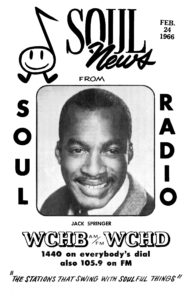
He tied in the success of R&B stations in the past few months with the civil rights movement — “We’ve become more and and more a source of information. We’ve doing a much better job of reporting the news that involves Negroes than the other stations in now. Whereas R&B stations used to be mostly for the kids, this is no longer true.”
The station, he said, helped “a good deal” in settling the people down during a recent flare-up.” George Wilson, program director of WHAT in Philadelphia, said there’s no question about the status of the R&B deejay improving. The National Association of Radio Announcers, he said, had helped enormously. “There’s a growing substance to the organization and it’s making an influence. “Nowadays, the successful R&B DJ assume a role of leadership that we didn’t before. We must assume the responsibility of uplifting the kids.”
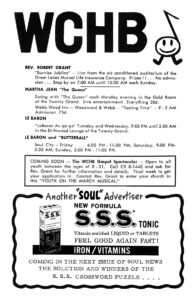 WDIA in Memphis sets in an enviable position; it has been No. 1 in the market for about 17 years, said program director Bob McDowell, largely through community involvement. The station supports 145 baseball teams with equipment, provides two buses to take crippled children to school daily, supports school for crippled children, plus other good-will projects.
WDIA in Memphis sets in an enviable position; it has been No. 1 in the market for about 17 years, said program director Bob McDowell, largely through community involvement. The station supports 145 baseball teams with equipment, provides two buses to take crippled children to school daily, supports school for crippled children, plus other good-will projects.
McDowell, a recording artist for Fame Productions, said he felt the status of R&B deejays had definitely improved. “I can tell by the quality of the men who’ve come here in the past three years; they’re good, high quality personalities which is one reason why we’re on top.” The popularity of R&B music is growing, he said, “even here,” considered to be one of the leading R&B centers of the nation. END
_______________
Credit source information (as published): Billboard, August 13, 1966
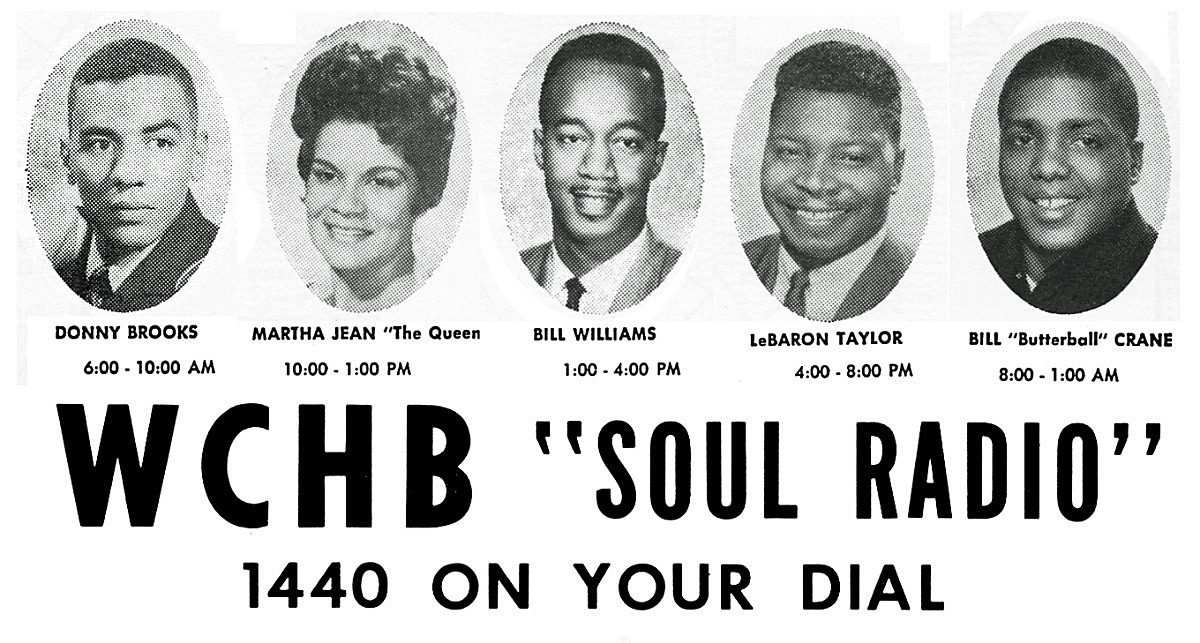
![]()




